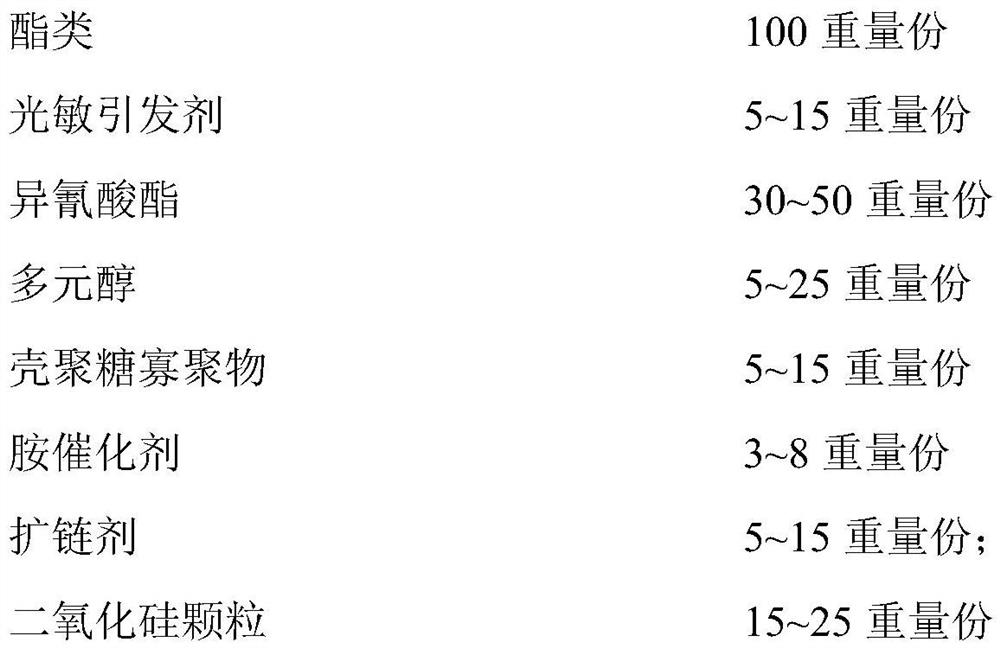Photosensitive resin, application thereof and preparation method of tooth retainer
A photosensitive resin, selected technology, applied in dentistry, orthodontics, orthodontics, etc., can solve problems such as nausea, vomiting, poor sensory impression of patients, loss of retainer, etc., to shorten the time of chairside operation, Avoid discomfort, high precision effect
- Summary
- Abstract
- Description
- Claims
- Application Information
AI Technical Summary
Problems solved by technology
Method used
Image
Examples
Embodiment 1
[0031] The raw material components of photosensitive resin in the present embodiment include:
[0032]
[0033] The esters are a mixture of lauryl acrylate and polyethylene glycol acrylate in a mass ratio of 1:1.
[0034] The photoinitiator is benzyl dimethyl ketal.
[0035] The isocyanate is toluene diisocyanate.
[0036] The polyol is a polyester polyol with a number average molecular weight of 50,000.
[0037] The chain extender is ethylenediamine.
[0038] The chitosan oligomer is O-carboxymethyl deacetylated polysaccharide, the number average molecular weight is 10000, and the degree of deacetylation is greater than 0.5.
[0039] The amine catalyst is bis(2-dimethylaminoethyl)ether and N,N-dimethylethanolamine.
Embodiment 2
[0041] The raw material components of photosensitive resin in the present embodiment include:
[0042]
[0043] The esters are a mixture of lauryl acrylate and polyethylene glycol acrylate in a mass ratio of 1:2.
[0044] The photoinitiator is diphenyl (2,4,6-trimethylbenzoyl)-phosphine oxide.
[0045] The isocyanate is toluene diisocyanate.
[0046] The polyol is a polyester polyol with a number average molecular weight of 50,000.
[0047] The chain extender is ethylenediamine.
[0048] The chitosan oligomer is O-carboxymethyl deacetylated polysaccharide, the number average molecular weight is 10000, and the degree of deacetylation is greater than 0.5.
[0049] The amine catalyst is bis(2-dimethylaminoethyl)ether and N,N-dimethylethanolamine.
Embodiment 3
[0051] The raw material components of photosensitive resin in the present embodiment include:
[0052]
[0053]
[0054] The esters are a mixture of lauryl acrylate and polyethylene glycol acrylate in a mass ratio of 1:2.
[0055] The photoinitiator is diphenyl (2,4,6-trimethylbenzoyl)-phosphine oxide.
[0056] The isocyanate is 1,6-hexamethylene diisocyanate.
[0057] The polyol is a polyester polyol with a number average molecular weight of 50,000.
[0058] The chain extender is ethylenediamine.
[0059] The chitosan oligomer is O-carboxymethyl deacetylated polysaccharide, the number average molecular weight is 10000, and the degree of deacetylation is greater than 0.5.
[0060] The amine catalyst is bis(2-dimethylaminoethyl)ether and N,N-dimethylethanolamine.
PUM
| Property | Measurement | Unit |
|---|---|---|
| particle size (mesh) | aaaaa | aaaaa |
Abstract
Description
Claims
Application Information
 Login to View More
Login to View More - R&D
- Intellectual Property
- Life Sciences
- Materials
- Tech Scout
- Unparalleled Data Quality
- Higher Quality Content
- 60% Fewer Hallucinations
Browse by: Latest US Patents, China's latest patents, Technical Efficacy Thesaurus, Application Domain, Technology Topic, Popular Technical Reports.
© 2025 PatSnap. All rights reserved.Legal|Privacy policy|Modern Slavery Act Transparency Statement|Sitemap|About US| Contact US: help@patsnap.com



